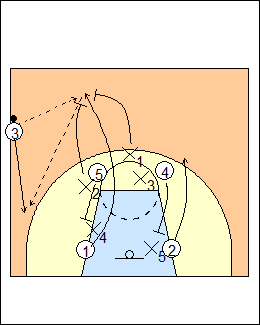Sideline inbounds
 | 1 Tactics to defend sideline inbounds plays in the defensive backcourt. See Defences - Tar Heels scramble, Baseline inbounds. 1) Basketball Canada (Level 3 Manual) There are variations of man-to-man defence that can be used (some coaches automatically switch to zone defence). a) Back to the ball X3 plays with his back to inbounder 3 (allowing other defenders to be more aggressive), facing attackers, moving to cut off a passing lane if a player tries to get open, and immediately returning when a defender has regained position. After the inbounds pass, X3 can trap the receiver or return to guard 3. |
 | 2 b) Centre field X3 plays in the middle of the lane, protecting the key, which can be more effective against a set play and has the bonus of resembling a zone. See Defence - Tar Heels scramble (Both). |
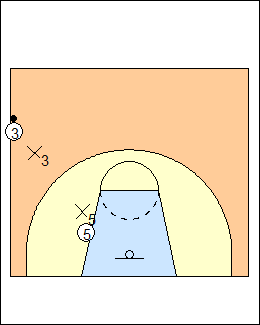 | 3 2) Del Harris (NBA Coaches Playbook) The basic plan with the Dallas Mavericks was to prevent a direct inbounds pass to the low post or the strong-side corner (which sets up a post entry or a 3-point shot). X5 denies 5, and X3 plays in the passing lane to the corner, with active hands. Often X3 will pressure 3 toward the baseline side for a count of two or three then jump to face the other attackers, trying to deny a pass to the first player who becomes open. At other times X3 will check the ball for a two-count then quickly find the one player they don't want to get the inbounds pass (e.g., Kobe Bryant). In any case, X3 must quickly get back to 3 on an inbounds pass. Some teams prefer to pressure the inbounds passer with one defender (or even two defenders) for the entire five seconds, which is most effective when one or two seconds remain and a lob is most likely (put a taller defender with active hands on the inbounds passer). Dallas has used their advantage in numbers to call - a shift to a zone - for a trap on the first pass below the foul line - for a trap when the ball is passed to the weakside - for switching certain or all players. You want to make it hard to run a play called during a time-out. It's dangerous to trap the inbounds pass, particularly if the inbounds passer is a good shooter, he's a dangerous man as a step-in shooter or slice cutter. |
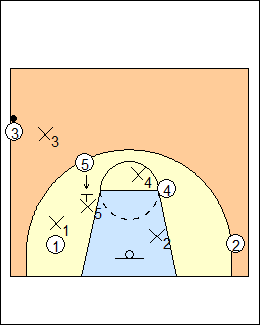 | 4 3) Herb Brown Play pressure defence, take something away from the opponent. a) They want to stop ball reversal, X3 pressures 3 to influence a pass to 1 in the corner, X1 bodies and three-quarters 1. X5 stops 5 from screening down, X4 overplays 4, and X2 sloughs off 2 until the ball is inbounded. If they front the post in man-to-man defence, they want to pressure the inbounds pressure and not be vulnerable to a lob pass. If they three-quarter the post, they may have X3 pressure the inbounds pass, or fake pressure on the ball. You can switch everything straight up, or invert then switch everything. Another option is a combination zone defence with a wild-card defender in the middle, who can be the inbound passer's man, your best interceptor or anticipator, or a big man. Defenders protect the goal in a position to double team and prevent a slice cut by the inbounder. |
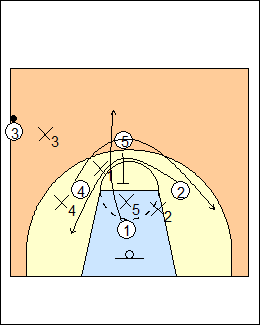 | 5 b) Short clock In short-clock situations (under 5 or 7 seconds) they may invert and switch every time attackers cross with or without the ball (here X1 and X5 have inverted), or simply switch whenever they cross. They also want to stand up screeners. Short-clock defence might be a zone trap where they channel or force the ball to the corner then aggressively trap the first pass, leaving open the player furthest from the ball. |
 | 6 4) Hoop Tactics a) Invert and jump switch X3 jams and pressures the inbounder, X5 and X1 invert when possible, along with X4 and X2, contact switch on downscreens (X1 and X2 jump out into the path of the cutters). |
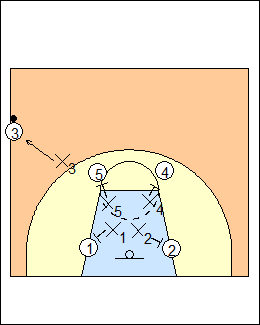 | 7 b) Jam (all-out disruption) Before the official hands the ball to the inbounder, defenders sag off and protect the basket, X3 plays off creating a 5-on-4. As 3 gets the ball, defenders X1-X2-X4-X5 step out and aggressively jam their opponents, don't switch or allow any cuts into the lane, take a charge if possible. X4 and X5 disrupt screens by not allowing 4 and 5 to move toward the basket, X1 and X2 prevent 1 and 2 from using screens with aggressive denial positions. X3 plays off in the passing lanes for a three-count then sprints back to the inbounds passer, pressuring with both hands up. |
This page was made with Basketball playbook from Jes-Soft
